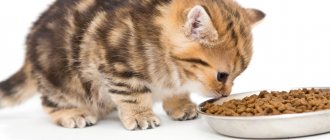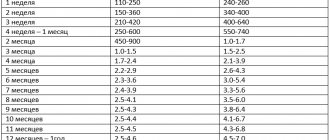Home » Useful Information
Weight gain during the period of active growth of a kitten plays a big role. Monitoring this indicator is important so that deviations can be noticed in time and the causes that caused them can be eliminated. To make it easier to keep weight characteristics under control, you can use special tables.
- 2 Why do you need to monitor a kitten’s weight at different periods of its growth?
2.1 What is a weight diary
- 3.1 Video: how to weigh a cat
- 4.1 Table: average body weight of kittens in the first 6 months of life
How does a kitten's weight change as it gets older?
If babies are healthy, they will gain weight daily. A day after birth (second weighing), the weight of newborns, if they are not sick, will increase by at least 8-10 g. The strongest kittens gain 14 g in weight by the second day of life. If a baby whose weight at birth corresponded to the norm, during the second day of life he did not gain at least 7 g, this should alert the breeder.
A newborn baby should weigh up to 170 g
During the first week of life, a newborn's weight may double.
Important! The kitten, who lived for 10 days and gained 168-174 g, has passed the first critical milestone. The majority of newborns die during this period. Almost always the cause of death is a lack of mother's milk.
Kittens are fed around the clock at intervals of two hours. When eating, the kitten should lie on its stomach. It is unacceptable to feed your baby adult food, such as cow's or goat's milk. This can cause diarrhea and, as a result, weight loss and death. The breeder must also weigh the kittens daily and record the results.
How much should a cat weigh at different stages?
Chihuahua weight by month and week: table
During the first 15–20 days of life, kittens spend most of their time sleeping. After about 16 days from the moment of birth, babies begin to be interested in the events happening around them, frolic and play.
The table shows the weight of a growing kitten by month:
| Kitten age | Kitten weight by month | Note |
| 1st day of life | Approximately 99 g | Average weight of a newborn kitten |
| 7th day of life | 149 g | If a 7-day-old kitten weighs less than 99 g, he is either seriously ill or malnourished. |
| 14th day of life (0.5 months) | 170 g | The weight of a kitten is given, which is not sick with serious illnesses, but also does not receive the maximum portion of attention. |
| 21 days of life (0.7 months) | 225 g | With special care, kittens reach the specified weight at the age of 14 days |
| 35th day of life (1.2 months) | 450 g | The weight of an absolutely healthy, naturally strong kitten is indicated. |
| 2 months from the date of birth | 900 g | The cat no longer feeds her kittens; their future fate depends entirely on the owner. The permissible minimum weight at this age is 710 g |
| 3 months | 1400 g | The average weight of a typical kitten is indicated. |
| 4 months | 1800 g | Average weight |
| 5 months | 2300 - 2900 g | Male kittens weigh more than their sisters |
The table shows the average weight. The exact indicators depend on the breed, gender and health status of the kitten.
Outbred kittens develop in approximately the same way as purebred kittens, only their mortality rate is higher due to the lack of additional nutrition.
A weak kitten weighs very little from the first days of life
Note! An animal that at the time of birth weighed less than its littermates will not be able to do without additional nutrition. Pushed away from his mother's nipples by stronger brothers and sisters, he does not receive enough nutrition, does not gain weight and becomes weaker.
Kittens stop needing mother's milk within a month after birth. By this time, their fangs and incisors have erupted, their ears take a vertical position (in representatives of straight-eared breeds), and their weight reaches 440-470 g. A kitten that has reached six months of age is considered an adult and weighs about 3 kg.
Possible reasons why a kitten’s weight does not correspond to age standards
If your kitten's daily weighing shows an abnormality, it is important to quickly identify possible causes.
Before you panic, make sure you choose the right weight chart. Different breeds have different weight standards, and there is no universal value for all newborn kittens.
The cause of a kitten's low weight may be malnutrition. Watch him when he is near his mother. If your cat has many siblings, the stronger kittens may push him away from the cat. Then the newborn needs to be helped to get to the nipple or fed with a special mixture.
Their growth and development depend on the nutrition of kittens
The problem could also be with the cat. If her milk is not enough, then all babies will gain weight poorly. Then the kittens need to be fed additionally with formula.
If even after introducing complementary foods the kitten does not gain weight, and you cannot find an explanation for this, the baby may be sick. In this case, take him to the vet.
Rules for weighing kittens
German Shepherd weight by month: table
Kittens must be weighed every day. If they look healthy, once is enough. Sick newborns, as well as those whose weight at birth was less than 80 g, are weighed twice a day. The weakest and most disease-prone babies are usually born in large litters (5 or more kittens).
Important! Experts recommend weighing them at the same time to get the best idea of newborns' rate of weight gain. Without this, the breeder will not be able to determine the amount of additional nutrition. Overfeeding kittens is no less difficult than underfeeding.
During the weighing session, the mother cat must be kept near the kittens so that she can see what is happening with her children. Excessive worry can negatively affect the quality of mother's milk. To create the most accurate picture of kittens growing up, experts advise:
- Mark identical kittens with different colored food dyes. This will make it easier to identify them. The tags will have to be periodically updated, since the cat, licking the babies, will wash them off;
- use electronic kitchen scales as the most accurate;
- record weighing results.
Second week of life
At 10 days of age, babies' visual organs begin to open and their first hearing abilities appear. They already confidently respond to sound sources, the most significant of which for them can be called the meowing of a cat. Indeed, by 2 weeks, babies’ eyes are open, but their vision is still difficult to call clear: they see everything blurry and fuzzy.
The further development of kittens can be negatively affected by their separation from their mother at such an early age. In the first weeks after birth, for every baby, a cat is not only care, warmth and protection (including immune protection, with the help of antibodies that they receive in regular portions of colostrum and milk). Separation will also negatively affect the pet’s future relationships with people, other animals, and its learning abilities.
What does weight depend on?
Yorkie weight by month: table, standard, how many months it takes to grow
Male kittens weigh more than females as they grow up. With each new weighing, the difference increases. The weight of mature males and females is influenced by a number of factors.
Bengal cats
During the first week of life, the weight of a Bengal kitten can reach 250 g, and after another three weeks the baby will weigh from 400 to 500 g. A three-month-old teenager weighs about a kilogram.
A Bengal kitten reaches 1 kg at 3 months
Bengals are a fairly heavy breed, but they are never fat. Kittens are very active and energetic, they run a lot, they are always in excellent physical shape, although they look well-fed and even overfed. They owe their appearance to their natural muscularity.
Note! The weight of a Bengal kitten depends to the greatest extent on the development of its muscular system. We must not forget that Bengals are big-boned animals.
"British"
On the 7-8th day of life, 70-gram babies already weigh 110-150 g. When they are two weeks old, their weight will increase to 210-420 g. The specific weight depends on gender, health status and the number of kittens in the litter.
Scottish Fold
If at birth cats of this breed weigh 70-120 g, then after two weeks these figures increase to 440 g. A two-month-old “Scottish” kitten weighs about 800 g. After another month and a half, its weight will increase to 1.5 kg.
Representatives of this breed, even when they grow up, do not cease to look like teddy bears with a rounded head on a short neck and large, widely spaced round eyes. Males that have reached puberty weigh from 4 to 6 kg, and females - from 2.7 to 4 kg.
“Scots” are usually good-natured and calm. They love to be outdoors and never miss an opportunity to participate in outdoor games. Loneliness and a sedentary lifestyle make them depressed and, as a result, lead to obesity.
Siberian cats
Siberian cat kittens are born weighing 60-130 g. Girls and the weakest newborns weigh less, boys, as well as kittens born at the beginning of the litter, have the greatest weight. During the first month of life, their weight increases by 12-15 g daily.
Sphinxes
Representatives of this species require high-calorie food to avoid hypothermia. The weight of females that have reached the age of 8-9 months can reach 3-4 kg. Males weigh from 4 to 5 kg.
The Sphynx needs to be fed a special diet
Sphynx kittens are not separated from their mother until they are one month old. During this period they feed on her milk.
Thai cats
The weight of a 3-month-old male can reach 1.8 kg. A female at this age weighs about one and a half kilograms. When the kittens are six months old, the male will weigh approximately 2.9 kg and the female 2.3 kg.
Why do you need to monitor a kitten’s weight at different periods of its growth?
A kitten's weight is a very important aspect of its development. The baby's weight needs to be monitored for several reasons. For example, by the age of one month, a kitten can weigh up to 500 grams. If his weight differs from this indicator in the direction of decrease, this may be caused by the following reasons:
- diseases, congenital or acquired;
- numerous litters;
- the mother’s lack of a complete diet that can provide nutrition for both the cat herself and her babies.
During the feeding period, the cat's food volume should be increased by 30% of the normal daily intake.
An underweight kitten may indicate that the baby is malnourished. He becomes lethargic, sleeps a lot, and apart from the general mass of kittens. In this case, you need to increase the amount of food for the nursing cat and monitor how long the weak baby stays at her breast.
Once I brought foundlings to my nursing cat. They were left without a mother, and besides, unkind people simply abandoned them to their fate. The two babies quickly got used to it, actively sucked the cat and did not differ from her “native” kittens. One kitten was very weak, he could not defend his place at the nipple and was often left out of work. Sometimes he still managed to get comfortable, but he quickly got tired and soon fell asleep without having eaten enough. Since I closely followed the adaptation of foundlings, I immediately noticed this (literally within 24 hours). The baby had to be fed separately. I gave him a special mixture, but also tried to get him to latch on to the cat’s breast more often (the more lively brothers had to be pushed aside for a while). As a result, this baby still lagged behind the others in weight, but caught up with them in height by about a year.
If a kitten is diagnosed with any disease, then to correctly calculate the medicinal suspension you will also need to know the exact weight of the animal. Therefore, a conscientious owner always monitors this indicator.
What is a weight diary
Every caring owner should keep a kitten's weight diary. This must be done regardless of whether the kitten grows up alone or with its mother cat and brothers. It is necessary to record all weight indicators in the diary, which can later help track whether the baby is developing normally.
The weight diary can be kept in any form, as convenient for the owner. This is an ordinary notebook for me. In it I write down the date of birth of the kittens, the names I gave them, as well as everything related to caring for them. This is not only their weight, but also the dates of treatment for fleas and worms, as well as the dosage of drugs (which, by the way, depends on weight). This is very convenient because over time I forget when, for example, I processed animals. A hint notebook helps me remember, especially since I now have 4 cats and a dog, so it’s quite possible to forget or confuse something.
How to prevent obesity in kittens
The change in nutrition plan is carried out gradually. Experts advise extending the transition to a diet for 7-14 days. If the kitten does not receive its usual food for 3 days, and the new food is not to its taste, the period of forced fasting may affect the functioning of the liver. The best way to transfer an animal to a new food system is to gradually, in small portions, replace the usual food with dietary food.
Important! To prevent the kitten from overeating, portions must be dosed, and feeding should be done strictly according to the clock. If food is constantly at the animal’s disposal, it will be difficult for the owner to keep track of exactly how much the baby eats and at what time.
After filling the bowl with food, leave it for about 20 minutes and then remove it until the next meal. If the cat has already reached adulthood, it is recommended to give food 3-4 times a day during the first week, and 2-3 times a day during the second week. Ultimately, the daily dose is divided into 2 doses.
Portion sizes depend on the type of food and calorie content. The animal should receive the recommended daily dose corresponding to its weight (indicated on the package).
Feeding and maintenance
We found out how much a kitten should weigh at 3 months. Now let's talk about how to feed the little furry little prankster. And how to care for it.
Let's start with nutrition. The owner needs to remember that a lot depends on a balanced diet. Please do not feed your baby with economy class kitten food. Yes, they are available and cheap. But the quality is lacking on both legs. Feeding a kitten this kind of food is the same as feeding a human child instant noodles. Is there much use in it? And how long will you be healthy enough to digest this crap?
What if you don’t have money for good food? He's expensive. Feed natural food, this is not a problem. Chicken and turkey are not the most expensive meats. Vegetables and cereals are also not incredibly expensive products.
Milk is getting more expensive, it’s true. But there is no need to give milk to a three-month-old animal every day. It won't do any good. Three times a week you can pamper yourself with kefir and cottage cheese. Once a week, give a boiled egg, or rather a half or a quarter of it.
Did the owner finally decide to feed? Let him choose super-premium class or holistic. They are not cheap, but the quality is simply excellent.
We sorted out the diet. Let's move on to the content. What does the baby need?
- A lounger or a rest house. The kitten will sleep in it and hide when it needs to be alone.
- Scratching post. You can buy the simplest one, mounted on the wall. Or you can take a whole cat town with a scratching post, a house and toys. It all depends on the financial situation of the owners.
- Bowl for water and food.
- Toys.
- Nail clippers or nail scissors. Useful from the age of six months for trimming nails.
- Cotton swabs. Needed to remove discharge from the eyes. The kitten is examined daily. The owner checks the cleanliness of the ears and eyes. Dirt and discharge are removed using a dampened swab. The ears are cleaned with cotton swabs.
- We now know how much a kitten should weigh at 3 months. By the way, scales will be very useful for him.
- Tray and filler. The kitten has done its business, the spoiled litter is removed immediately, and a new one is added in its place.
Long-haired breeds require regular brushing. Kittens and cats should not be washed frequently. Twice a year is enough.
How much should a grown-up cat and cat weigh?
Bengal kittens stop growing when they reach 2 years of age. By this time, the weight of the female can reach from 3600 to 4500 g. The male will weigh 4500-6800 g. In some cases, the weight of an adult male Bengal can reach 10 kg or, conversely, not reach the norm (the minimum weight of a male is 3600 g), but This is rather an exception to the rule, rather than the norm. The same can be said about females. Female cats sometimes weigh much more than males.
Many breeders of Bengal cats believe that the weight of their pets exceeds the norm or, conversely, is below the acceptable minimum. The fact is that cats of this breed remain children longer than their relatives. They usually reach full physical development at the age of 3 years or so.
“The British” do not control their food intake, which is why they later suffer from obesity
Important! A peculiarity of British cats is their tendency to obesity. If the breeder does not regulate the pets' diet, they quickly gain excess weight.
Table for calculating the weight of a mature British cat by age.
| Gender | Permissible minimum weight | Permissible maximum weight | Expert opinion |
| 2 year old male | 4.1 kg with a height of 40 cm | 7.7 kg with a height of 50 cm | 6 kg regardless of height |
| 2 year old female | 3.2 kg with a height of 35 cm | 5.4 kg with a height of 45 cm | 5 kg regardless of height |
If the British dog's weight falls far short of the acceptable minimum, the breeder should think about additional nutrition. A veterinarian will help you decide on the amount and composition of feeding. The procedure for treating obesity in cats is not much different from the treatment for people suffering from excess weight. The best cure in both cases is diet and physical activity. If an obese kitten whose body is constantly growing, he most likely leads a sedentary lifestyle and receives an excessive amount of food. It is enough for the breeder to change the lifestyle of the ward.
For mature Siberians, a weight of 4 to 10 kg is considered normal. Both males and females are distinguished by their large dimensions and powerful muscular bodies. Female Siberian cats weigh between 4 and 6 kg. Males, if not sick, reach 6-10 kg.
For your information! To find out how much a Siberian cat weighs, you will need a bathroom scale. Experts suggest the following method: the breeder first weighs himself, and then, picking up the cat, weighs himself again. All that remains is to calculate the difference.
Thai male cats, upon reaching maturity, weigh from 5 to 6.8 kg. The weight of mature females ranges from 3.6 to 5.4 kg. Cats of this breed are natural gourmets; they never miss an opportunity to eat deliciously, so breeders have to constantly monitor their weight.
Detailed schedule
A detailed chart of weight gain in domestic cats is as follows:
- newborn babies: females – 116–145, males – 118–147 g;
- 1 week: 240–260, 240–280 g;
- 2 weeks: 340–400, 350–420 g;
- 4 weeks: 560–740, 630–820 g;
- 6–8 weeks: 1.15–1.4, 1.2–1.5 kg;
- 10–12 weeks: 1.7–2.3, 1.8–2.3 kg;
- 14–16 weeks: 2.6–3.6, 2.7–3.8 kg;
- 5 months: 2.9–4.3, 3.2–5.5 kg;
- 6 months: 3.2–4.5, 3.9–6 kg;
- 7 months: 3.5–4.9, 4.2–6.5 kg;
- 8 months: 3.8–5.2, 4.5–6.9 kg;
- 9 months: 4.1–5.5, 5–7 kg;
- 10 months: 4.2–5.8, 5.3–7.7 kg;
- 11 months: 4.3–6.1, 5.6–8 kg;
- 1 year: 4.5–6.8, 5.7–9 kg.
After 1 year, the weight of animals directly depends on the breed and nutrition.
We recommend this article:
How to properly fatten a cat without harming your pet's health
Number of kittens in the litter and their weight
The very first pregnancy ends for a cat with the birth of 2-3 kittens. Their weight in most cases is maximum - about 170 g. However, it is possible that weak and extremely light kittens will be born in the first litter. The minimum weight of a viable baby is:
- 60 g for a Siberian cat cub;
- 70 g for a Scottish Fold kitten and for representatives of most breeds.
For your information! After the second and subsequent pregnancy, the cat will become the mother of at least 8 kittens. Some females are capable of acquiring 8 or even 10 kittens when giving birth for the first time, but such cases are quite rare.
A purebred cat can give birth to up to 15 kittens.
A pregnant cat can give birth to 1 to 6 kittens
This number is due to the need to continue the race, despite the hostility of the environment, where mortality is much higher than among purebred cats living in comfortable conditions.
What can a kitten weigh at birth?
The following factors influence the initial weight of the newborn:
- breed: Maine Coons are born larger than Siamese kittens;
- gender: cats are larger than female cats;
- mother's age: firstborns and animals over 6 years old give birth to small kittens;
- number of cubs: the more kittens in the litter, the smaller they are.
If the newborn's weight ranges from 60 to 160 g, there is nothing to worry about.
Diseases in cats that lead to obesity
The cause of extra pounds may not only be overeating.
Obesity is the scourge of many cats
The following diseases are often triggers of obesity:
- hypothyroidism (hormonal disease of the thyroid gland);
- insulinoma (pancreatic tumor);
- hypothalamic disorders;
- problems with the pituitary gland, the organ responsible for the production of hormones that affect metabolism.
Thus, everyone who wants to raise a healthy pet is obliged to control the weight of the animal. It is also important to dose the cat’s food so that he does not suffer from obesity later.











